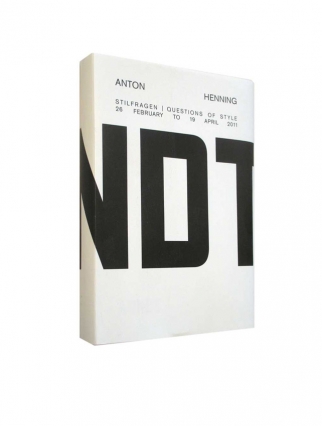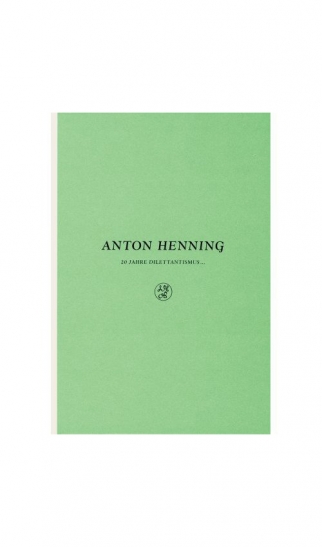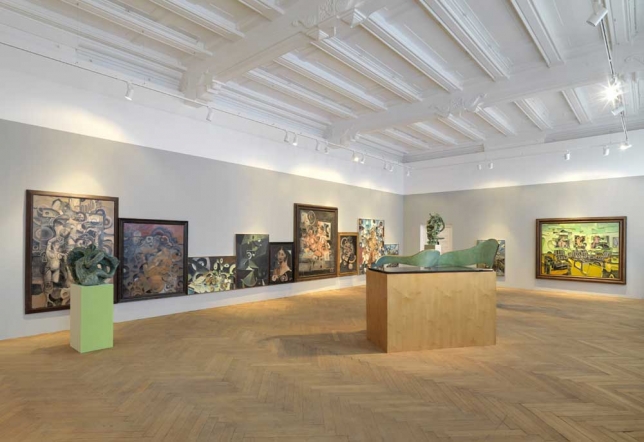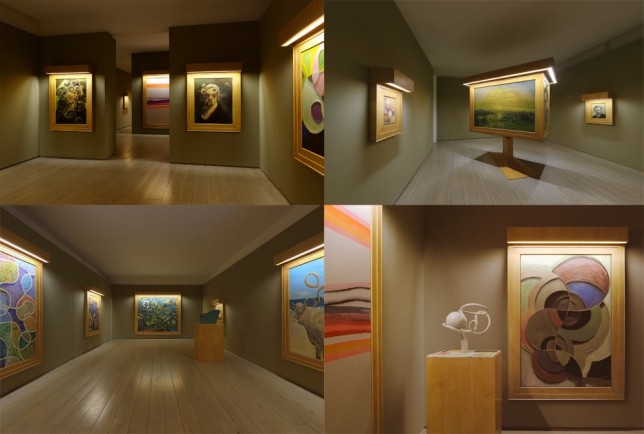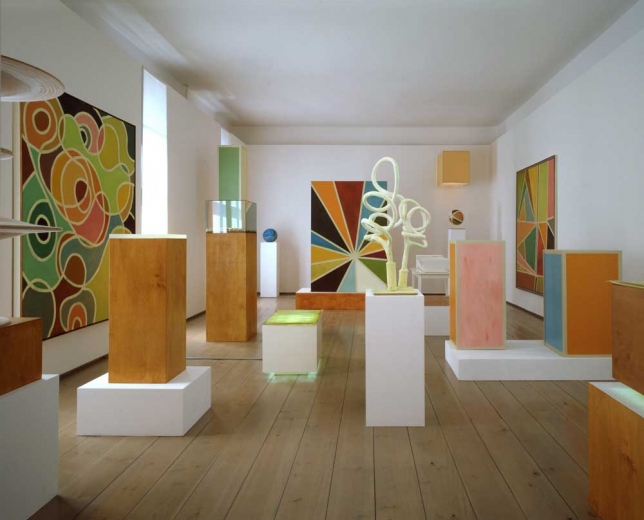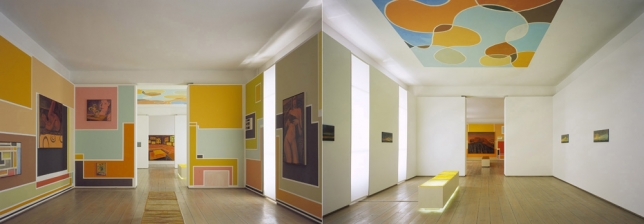26.02. - 19.04.2011
ANTON HENNING
STILFRAGEN | QUESTIONS OF STYLE
Solo exhibition at ARNDT, Berlin
DOWNLOAD EXHIBITION CATALOGUE.
OPENING: FRIDAY, 25 FEBRRUARY 2011 | 6 TO 8 PM
Anton Henning
born in 1964 in Berlin
lives and works in Manker, Germany
The oeuvre of Anton Henning is characterised by an unremitting engagement with a heterogeneity of art historic styles, genres and media. Ranging from painting, sculpture, video and installation, his works are laden with visual allusions and art historical quotes, that reveal the artist’s playful use of irony and his sense for irritating the educated beholder. With ease he appropriates the vocabulary of modernism, arbitrarily mixing geometrical and gestural abstractions with figurative motives. And yet, his convergence of style and subject matter is not confined to the two-dimensional pictorial space. Recurrently, he transposes his sujets into three-dimensional space, introducing yet another level of references. These installations, often referred to as “Salons” – often accompanied by self-designed furniture by the artist, not only allude to traditions of institutional critique during the 70ies, but also figure as reinterpretations of the Salon – the epitome of the bourgeois’ cultural sphere of the late 19th century.
Anton Henning has gained an international reputation through numerous solo exhibitions in European, Asian and American institutions and galleries. Only recently, two Berlin institutions – the Georg-Kolbe Museum and the Haus am Waldsee – dedicated parallel solo exhibitions to the artist (2009). Further exhibition locations include the Wilhelm-Hack Museum, Ludwigshafen (2009), Kunsthalle Mannheim (2009), Arp Museum, Remagen (2008), S.M.A.K. Stedelijk Museum voor Actuele Kunst, Ghent (2007), MARTa Herford (2005), Haus Esters, Krefeld (2005), Museum für Moderne Kunst, Frankfurt/Main (2005), Museum of Art Lucerne (2003), and the De Pont – museum of contemporary art, Tilburg (2002). Recent group exhibitions include „Neue Heimat,“ Berlinische Galerie, Berlin (2007), „Neue Malerei. Erwerbungen 2002–2005,” Museum Frieder Burda, Baden-Baden (2006), and “Size Matters: XXL – Recent Large-Scale Paintings,” Center for Contemporary Art, New York (2008).
EXHIBITIONS:
26.02. – 19.04.2011
Anton Henning
“Stilfragen | Questions of Style”
Solo exhibition at ARNDT, Berlin
CATALOGUE AVAILABLE (printed)
ONLINE VERSION
06.10.10 - 04.12.2010
Anton Henning
“Vier konventionelle Bilder und eine Bronzeskulptur | Four conventional paintings and one bronze sculpture”
Solo presentation at ARNDT, Berlin
29.4. - 30.5.2010
“Changing The World”
Group exhibition with works by
Erik Bulatov, Sophie Calle, William Cordova, Wim Delvoye, Anton Henning, Thomas Hirschhorn, Ilya und Emilia Kabakov, Jitish Kallat, Jon Kessler, Karsten Konrad, Julije Knifer, Enrique Martinez Celaya, Josephine Meckseper, Vik Muniz, Muntean Rosenblum, Julian Rosefeldt, Charles Sandison, Dennis Scholl, Nedko Solakov, Hiroshi Sugito, Ena Swansea, Mathilde Ter Heijne, Keith Tyson, Ralf Ziervogel
at ARNDT, Berlin
14.11.08 – 14.01.2009
Sculpture Is...
Group exhibition with works by
Veronika Brovall , William Cordova , Anton Henning, Mathilde ter Heijne , Thomas Hirschhorn , Jon Kessler , Douglas Kolk , Karsten Konrad
at Arndt & Partner, Berlin
04.03.–9.04. 2008
Anton Henning
20 Jahre Dilettantismus …
Solo exhibition at Arndt & Partner, Berlin
CATALOGUE AVAILABLE
03.09. – 08.10.2005
Anton Henning
“27 mainly quite appealing sculptures”
Solo exhibition at Arndt & Partner, Berlin
05.06. – 31.07.2003
Anton Henning
“Salon”
Solo exhibition at Arndt & Partner, Berlin
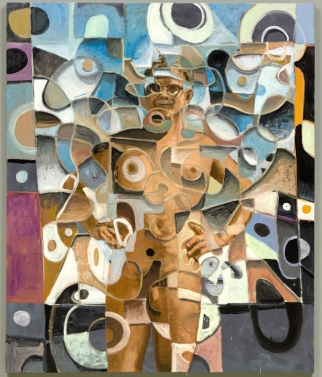 Anton Henning, Strandläufer No. 3 (kurvistisch) (AH 2011-013), 2010, Öl auf Leinwand | oil on canvas, 188,6 x 157,3 cm | 74.25 x 61.93 in, HENN0342
Anton Henning, Strandläufer No. 3 (kurvistisch) (AH 2011-013), 2010, Öl auf Leinwand | oil on canvas, 188,6 x 157,3 cm | 74.25 x 61.93 in, HENN0342 Publication: Anton Henning, 2011
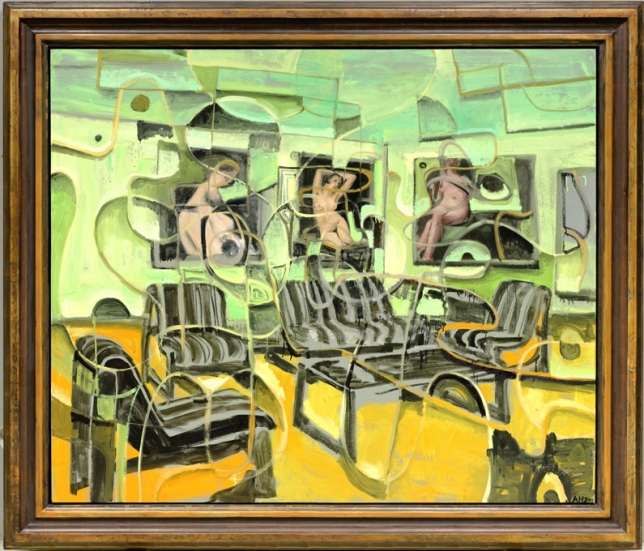 Anton Henning, Interieur No. 478 (AH 2011-015), 2010, Öl auf Leinwand | oil on canvas 157,3 cm x 188,2 cm , Gerahmt | framed: 191 x 222 x 8 cm | 75.2 x 87.4 x 3.15 in , HENN0343
Anton Henning, Interieur No. 478 (AH 2011-015), 2010, Öl auf Leinwand | oil on canvas 157,3 cm x 188,2 cm , Gerahmt | framed: 191 x 222 x 8 cm | 75.2 x 87.4 x 3.15 in , HENN0343
This book was published on occasion of Anton Henning's solo exhibition "Stilfragen /Questions of Style" 2011 at ARNDT
Self-published by ARNDT
57 pages, many colour plates
unbound hardcover
German / English
Price 20 €
Publication: Anton Henning, 20 Jahre Dilettantissmus…2008
This book was published on occasion of a solo exhibition of Anton Henning at Arndt & Partner Berlin 2008
Publisher: Richter Verlag, Düsseldorf, 2008
Edited by Arndt & Partner Berlin / Zurich
Language: German / English
Hardcover, 120 pages, many colour plates
With a text by Joerg Bader
ISBN: 978-3-937572-90-1
Price 28 €
Exhibitions
"Four conventional paintings and one bronze sculpture"
On the occasion of the art froum Berlin we are presenting works by Anton Henning in our showroom.
The oeuvre of Anton Henning is characterised by an unremitting engagement with a heterogeneity of art historic styles, genres and media. Ranging from painting, sculpture, video and installation, his works are laden with visual allusions and art historical quotes, that reveal the artist’s playful use of irony and his sense for irritating the educated beholder. With ease he appropriates the vocabulary of modernism, arbitrarily mixing geometrical and gestural abstractions with figurative motives. And yet, his convergence of style and subject matter is not confined to the two-dimensional pictorial space. Recurrently, he transposes his sujets into three-dimensional space, introducing yet another level of references. These installations, often referred to as “Salons” – often accompanied by self-designed furniture by the artist, not only allude to traditions of institutional critique during the 70ies, but also figure as reinterpretations of the Salon – the epitome of the bourgeois’ cultural sphere of the late 19th century.
04.03.–9.04. 2008
Anton Henning
"20 Jahre Dilettantismus …"
Solo exhibition at Arndt & Partner, Berlin
PRESS RELEASE
Arndt & Partner Berlin is delighted to present the third solo show of works by Anton Henning entitled "20 Jahre Dilettantismus ..."
Anton Henning has been painting for over twenty years. His method could be compared to that of a card player: collecting, shuffling and dealing. The painter collects motifs and styles, shuffles them into endlessly new combinations and gleefully deals them out again, that is to say, presents them differently every time. The motifs can be as classic as a bunch of flowers or a portrait, and as bizarre as a gas station at sunset or a beach scene without a horizon line. The styles explicitly refer to Courbet and Matisse, Warhol and Polke. When shuffling, the painter regularly smuggles in a few of his older canvasses, thereby subjecting his work to a certain historicization - he not only reflects on aspects of the history of painting, but on his own history, as well.
The way in which he unifies this heterogeneity and supplements or mixes it with abstract motifs marks him as a maverick among contemporary painters. And similarly to a number of others of his generation, he extends the field of battle well beyond the picture frame: He also styles the walls, the carpet and the furniture. Henning's entire world is determined by painting. He designs an elegantly simple set of living-room furnishings and then hangs his paintings - upon which similar salon scenes are depicted - above the couch. The canvasses are placed on painted patterned walls, which are often given the same mauve hues as the carpets. His abstract compositions are frequently rendered in marshmallow colors, and constitute an even more distanced critique of abstractionist heroics (e.g. abstraction as the embodiment of Western freedom during the Cold War) than Neo-Geo did in the 1980s. And if that wasn't enough, female nudes frequently manage to sneak into his wonderfully detailed exhibition spaces: With Henning it's only a small step from the creative freedom of abstraction to unbridled naturist eroticism.
The paradigm of Henning's art is the bourgeois salon, less on the scale of a four-room apartment than of a stage set. He undertakes to reconstruct - within art institutions - the private context of the gentleman, so as not to abandon his works to the colorless, lifeless ambiance of the white cube. He creates within the museum the environment in which his works - once sold - will appear in private homes, which sounds deadly serious, but in fact is unfailingly done with great wit and irony.
Often an artist's studio is the only place you'll find his or her complete world. With Henning, the situation is reversed. He is constantly creating new salons in galleries or museums - ever-changing spatial-emotional-intellectual entities - that provide an insight into his cosmos, though not necessarily enabling us to get a grip on it. He applies 20th-century stylistic elements and a contemporary perspective to resurrect the artist's salon of the 19th century. And for each new exhibition, he jumbles everything up again like a card player, and in doing so asks: What was the promise of Modernism?
The exhibition will be accompanied by a catalogue.
Anton Henning, born in Berlin in 1964, lives in Manker near Berlin. He has gained an international reputation through numerous solo exhibitions in Europea, Asian and American galleries, as well as in institutions such as the S.M.A.K. Stedelijk Museum voor Actuele Kunst, Ghent (2007), MARTa Herford (2005), Haus Esters, Krefeld (2005), Museum für Moderne Kunst, Frankfurt/Main (2005), Museum of Art Lucerne (2003) and the De Pont Foundation, Tilburg (2002). Recent group exhibitions include "Neue Heimat", Berlinische Galerie, Berlin (2007), "Neue Malerei. Erwerbungen 2002-2005", Museum Frieder Burda, Baden-Baden (2006). His work is currently on show in the solo exhibition "[…] und immer eine gute Linie, Zeichnungen und Skulpturen 1984-2007", Arp Museum, Remagen (until 30.3.2008), and in the group exhibition "Size Matters: XXL - Recent Large-Scale Paintings", Hudson Valley Center for Contemporary Art, New York (until early 2008).
03.09. – 08.10.2005
Anton Henning (GER)
“27 mainly quite appealing sculptures”
Solo exhibition at Arndt & Partner, Berlin
PRESS RELEASE
The paintings of Anton Henning easily provoke a reproach from the
critical beholder. Overladen with visual allusions and art historical
quotes, his densely coloured, impassioned panoramas often verge on
the borders of good taste. While developing a very broad formal
repertoire, the artist generously and boldly appropriates the
vocabulary of modernism. Seemingly arbitrary he mixes stylistic
characteristics of Courbet, Mondrian, or Warhol. Geometrical and
gestural abstractions hover within landscapes, interiors, still-lives or
nudes, while garish colours collide with desaturated hues, creating an
infernal canon of our collective visual memory.
Yet, Anton Henning does not simply cater to the art historically
educated viewer. He misleads him by combining motives of
modernist masterpieces with ordinary images from the 21st century.
Palm tree-lined beaches and Picasso, pin-ups and Picabia appear
within the same pictorial space – and yet, are not a collage. Both
worlds are merged artistically by means of a vigorous and confident
handwriting. By doing so, the artist consciously flirts with the
decorative and the superficial.
The convergence of style and subject matter is as much part of
Henning’s artistic language as the playful interweaving of
autobiographical sujets and historical references. Whilst he plays
with familiar visual codes, he places himself amongst historical
figures, thus claiming equal prominence for himself. The walls in
his painted Interieurs, for example, display his own paintings right
next to Warhol’s flower pictures. Furthermore, their warm and
glowing colours evoke Matisses’ paintings of his studio. Are these to
be read as an atmospherical homage to the modernist masters? Or
rather as an ironical commentary? Probably both – in any case Anton
Henning’s paintings take the viewer on a journey to the modernist
past, which is undermined by its existence as a quotation.
While the flat picture plane is an integral part of Anton Henning’s
oeuvre, he does not merely confine himself to this medium.
Recurrently, he transposes his sujets into three dimensional space,
introducing yet another level of references. In his installations he
questions deconstructivist approaches to the White Cube, alluding to
traditions of institutional critique during the 70ies. Further he
reinterprets the Salon – the epitome of the bourgeois’ cultural sphere
of the late 19th century. The walls of his three-dimensional Interieurs,
which he often refines with self-designed furniture, are composed in
geometrical fields of colour and adorned with his own canvases. His
paintings, again and again quoting his own pictorial vocabulary,
seem like obtrusive pop-ups, forbidding any concentration on the
monochrome geometrical patterns on the walls. His installations
thus seem like a picture-puzzle of his two dimensional compositions.
At Arndt & Partner, Berlin, Anton Henning will for the first time
exhibit sculptures, encountering yet another level in his oeurvre.
Through his mesmerizing sensuality and his respectful, but winking
commentary on the achievements of his artistic predecessors Anton
Henning purposefully incurs criticism. Even though his new works
are presented on pedestals and thus are reminiscent of sculptural
conventions, not all of them can be read as sculptures in the literal
sense. Rather, some of them are canvases fastened to cubical objects,
encouraging the viewer to walk around them. Besides, he will
present three-dimensional translations of his ornamental, abstract
shapes, that have for years untamingly been swirling through his
paintings. What we have known from Anton Henning’s (wall-)
paintings, is now blocking our way. ‘Sculpture is what you bumb
into, when you back up to see a painting’, Barnett Newman once
complained about the large scale works of his colleagues. His
statement does not apply to the oeuvre of Anton Henning: when we
are looking at his paintings, we are at the same time perceiving his
sculptures and the other way round.
05.06. – 31.07.2003
Anton Henning
“Salon”
Solo exhibition at Arndt & Partner, Berlin
PRESS RELEASE
Anton Henning: Salon
Anton Henning’s oeuvre is characterised by its inexhaustible range of subject matter and its stylistic diversity, that avoid any categorisation of his work. His latest works employ a variety of motives that originate from traditional genre painting, such as still-lives, landscapes, history-painting, interiors, and nudes. Pushing the boundaries of these genres, Henning adopts current themes of popular culture, ranging from pin-ups and flower pictures to sunsets behind palm tree lined beaches, and appropriates masterpieces from the heritage of Modernism. He balances between the most diverse modes of expression by combining figuration, gestural and geometric abstraction, as well as ornamental elements, resulting in vibrating compositions of colour.
Despite their heterogeneity, Henning's works continuously refer to one another and to the wider context of fine art on many different levels. Two recurring themes, which the title of the exhibition "Salon" refers to, are the examination of the conditions of artistic production and the determination of the own position. When the 'Salons' at the Louvre were established as regular public exhibitions in the middle of the eighteenth century, they offered an opportunity for artists to exercise their autonomy by liberating themselves from the small circle of patrons – and later on, in the Salon de Refuseés, also from the strict aesthetic regulations of the academy. Comparably, Henning's oeuvre investigates the possibilities of defining the role of the artist in the dizzying visual hegemony in our present time.
Especially Henning's complex pictorial "Interieurs", that seem to quote Matisse's paintings of his studio, reveal the artist's pluralistic and critical approach. The walls in these painted "Interieurs" display Henning's own paintings as well as reproductions and appropriations of modernist masterpieces. The paintings within these paintings comment on one another in an ironic dialogue and serve as signifiers in a intriguingly complex system of cultural, art historical and biographical references. Henning's seemingly opposing approaches, such as his more conceptual strategies, his playful and subversive humour, and the celebration of the sensuality of paint, contrast with one other in an exciting and exceptional way.
In his work "Interieur No. 207", presented in the gallery's showroom, Henning dissolves the categories of applied and fine arts by creating an expansive three-dimensional interior, in which he arranges his paintings. The walls are painted in various colours in order to match the paintings as well as the retro-design of the armchairs, the lamps and the carpeting, that transform the gallery space into a typical, pseudo-intimate salon. The artificiality of the atmosphere is subversively exaggerated, creating a sort of supermodern 'Salon'. Anton Henning's unique works intelligently play with diverse clichés such as beauty, luxury, pleasure or taste, that infiltrate not only all domains of design, but also influence the reception of artistic heritage and contemporary fine art.
Anton Henning was born in Berlin in 1964. After having lived in London and New York for a few years, he now lives and works in Manker, near Berlin, since 1994. Having successfully exhibited in Europe and the United States, he currently has an extensive solo show at the Kunstmuseum Luzern, Switzerland, from May 10th to July 27th. Arndt & Partner are delighted to announce their first exhibition by Anton Henning. Parallel to "Salon", the artist is presenting his exhibition "Sommertagstraum" at Wohnmaschine, Berlin, from June 5th to July 6th 2003.
